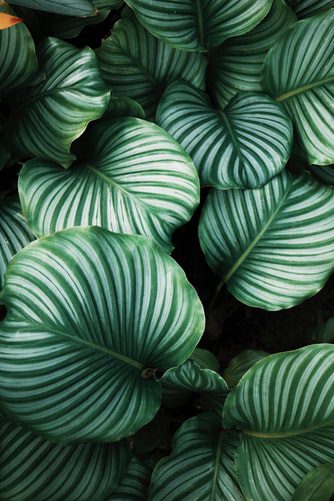Calathea is another genus of houseplants that you’ll often see at the nurseries. These plants are known for their gorgeous, often colorful leaves. You may also see these referred to as peacock plants, rattlesnake plants, or zebra plants. It’s also fairly easy to care for calathea plants!
The leaves come in a variety of colors from all shades of green to white, pink, purple, and red. Like many houseplants, calatheas are native to the tropical rainforests of Central and South America, which makes them well-adapted to indoor light conditions.
They also thrive in typical room temperatures and stay at a pretty manageable size, which makes them perfect for growing indoors!
Calatheas are relatives to the prayer plant, which gets its name from its leaves that fold at night like a pair of hands in prayer. Their care is very similar. They are sometimes sold as the same plant, but they are different.
Table of Contents
Prayer Plants vs Calathea
There are some key differences between these plants. First, calathea doesn’t fold up at night. These plants also grow very differently. Prayer plants and their relatives tend to grow low to the ground and are often used for ground cover while calatheas grow more vertically and develop longer stems.
Calathea leaves are also ridged while prayer plant leaves are more smooth.

Characteristics of Calatheas
Strong, brightly colored leaves
Calathea’s wide leaves can range from bright green to pink, purple, even red, and most calatheas have striped leaves of several different colors.
The leaves are also quite thick and hardy. Calathea leaves have even been used to carry and wrap goods in their native homelands!
Low Light Lovers
Calatheas enjoy lower light conditions, which makes them perfect for brightening up our homes and offices. Calatheas live in the lower regions of tropical rainforests and enjoy indirect sunlight.
Non-Toxic
Calatheas are non-toxic for both humans and animals, so this is a safe choice if you have pets or little ones around.
How to Care for Calathea Plants

Light
Calathea plants like low light conditions, so you can keep them deeper in a room with a window or in a room with a north-facing window. NEVER put them in direct sunlight, and avoid rooms with tons of windows. Too much sunlight can scorch the leaves or give them a faded appearance.
Water
Calatheas enjoy a moderate amount of water, so water them when the top inch of soil is dry. Make sure you put them in a pot with drainage holes and a well-draining soil. (Cactus soil can work, or you can mix some orchid bark with regular indoor potting mix.)
Temperature/Humidity
Calatheas thrive at normal room temperatures (65-80 degrees fahrenheit), and they also enjoy humidity. These plants will do well in a steamy bathroom that isn’t too bright, or on a pebble tray.
Fertilizer
Calathea plants enjoy fertilizer so they can grow large, colorful leaves. I love our Indoor Plant Food because it works perfectly for nearly all my houseplants (including calathea). And the best part is, it’s gentle enough to use with every water so you don’t even have to remember a fertilizing schedule! I just add some to my watering can when I make my rounds every week. It’s so easy!
A Gorgeous Houseplant
Calatheas are some of the most beautiful houseplants out there, and they aren’t that difficult to care for! As long as you can provide the right drainage and humidity, your calathea will reward you with tons of beautiful leaves that will brighten up any space in your home.
As long as there’s good light, of course.




